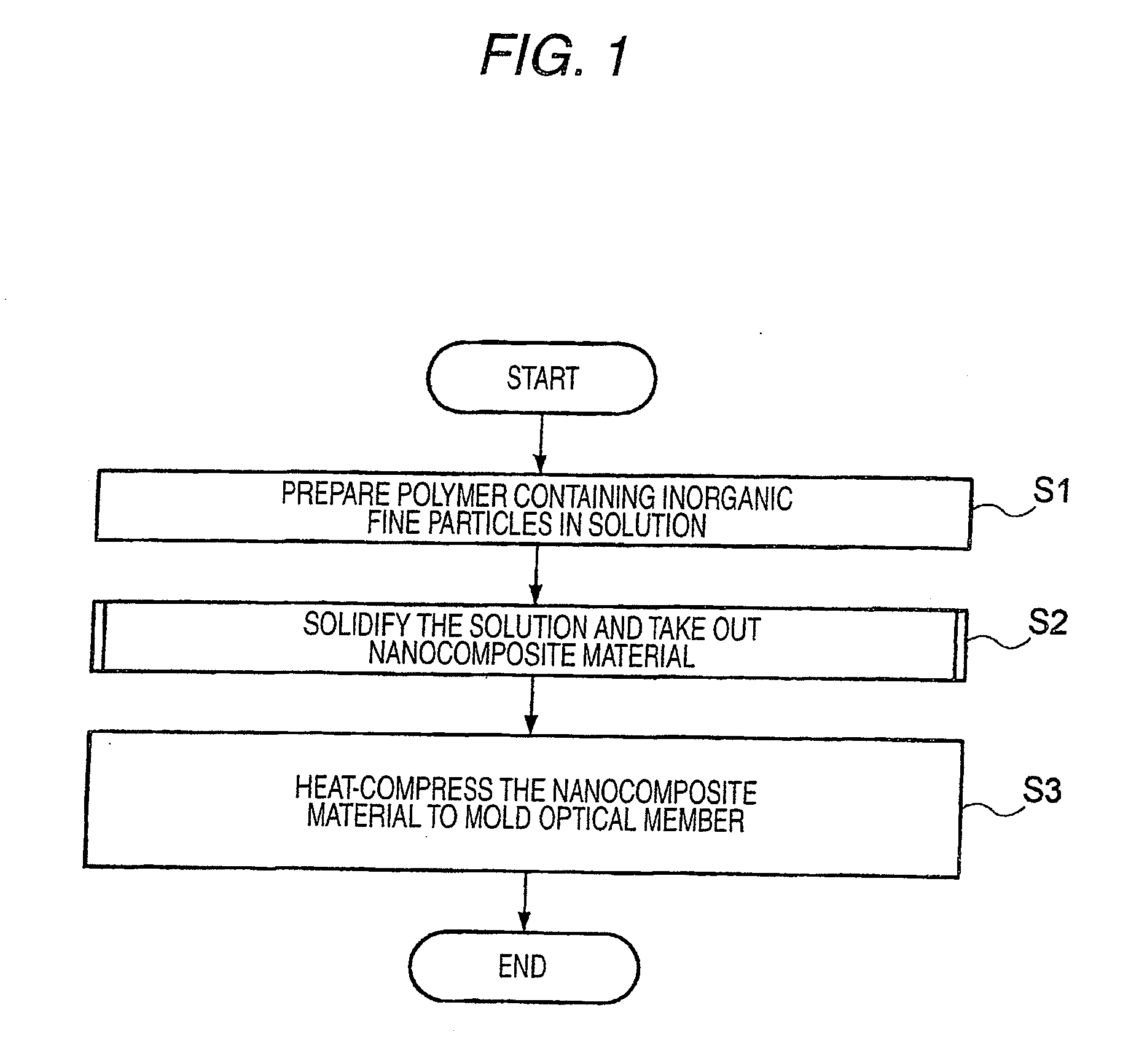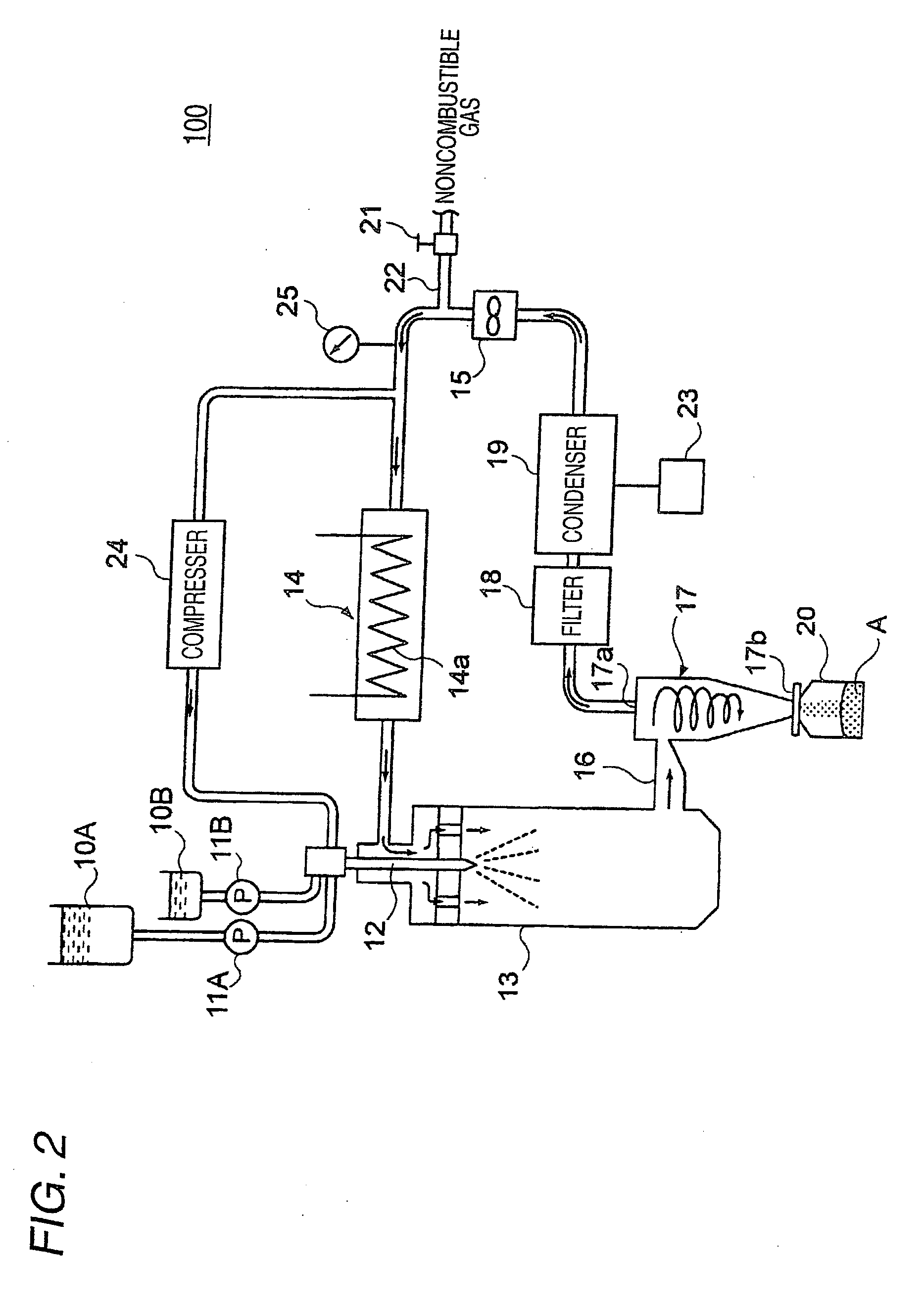Method for producing optical member and optical member formed by the production process
a production method and technology of optical components, applied in the field of producing optical components and optical components by the production method, can solve the problems of difficult to obtain stable optical performance, difficult to achieve the full effect of introducing inorganic fine particles, serious deterioration of fluidity of resins, etc., to achieve high accuracy, facilitate shape control of optical components, and increase design freedom
- Summary
- Abstract
- Description
- Claims
- Application Information
AI Technical Summary
Benefits of technology
Problems solved by technology
Method used
Image
Examples
first embodiment
[0049]In the first embodiment, in order to conduct drying of the solution in the step S2 shown in FIG. 2, it is assumed to utilize a spray drying apparatus 100 of the constitution shown in FIG. 2 as one example. In the case of utilizing this spray drying apparatus, the solution is introduced into a high-temperature gas as finely atomized droplets to dry. In short, the solution is dried as droplets having an increased surface area, and hence the time required for drying it can be markedly shortened. However, the drying degree of the powdery nanocomposite material obtained by the spray drying apparatus treatment is not necessarily sufficient, and further drying is conducted by using a vacuum drying apparatus (see FIG. 4 to be described hereinafter).
[0050]The spray drying apparatus 100 shown in FIG. 2 is equipped with a solution tank 10A for storing a solution containing a nanocomposite material; a solution-feeding pump 11A; a solution tank 10B; a solvent-feeding pump 11B; a spray nozz...
second embodiment
[0100]Next, a second embodiment of the process of the invention for producing an optical member will be illustrated below.
[0101]In this embodiment, drying of the solution in the step S2 shown in FIG. 1 is conducted by employing a freeze-drying method in place of the method of forming a powdery nanocomposite material from the droplets of the solution. This freeze-drying method is a method of obtaining a massive nanocomposite material by vacuum-drying the solution to form a solid product and taking out it.
[0102]Generally, in employing the freeze-drying method, the solution is dried without forming droplets, and hence the time required for drying becomes comparatively long in comparison with the spray drying method and the inkjet drying method due to the difference of surface area in a wet form. However, at the point of completion of this freeze-drying, the freeze-dried product is in a state of being dried to about the same level as with the dry nanocomposite material B obtained by fur...
modified example 1
[0115]In the above-described embodiment, it is assumed that the nanocomposite material taken out of the tray 74 after freeze-drying is pulverized to form a nanocomposite material which is used to mold an optical member. However, it is also possible to mold an optical member without pulverizing.
[0116]For example, as is shown in FIG. 11, in expectation of the final shape of a lens, a groove 74Ba having a shape approximate to the final shape after compression under pressure is formed in the surface of the tray 74B disposed within the freeze-drying apparatus, and the solution is poured into this groove 74B to conduct freeze-drying. Thus, a nanocomposite material 79B taken out of the tray 74B after freeze-drying is obtained as a preform having a larger thickness than that of the final shaped lens. This preform is heated and compression-molded in a mold which receives one preform to thereby obtain a final shape lens. This method permits metering in a solution state and not in a powder sta...
PUM
| Property | Measurement | Unit |
|---|---|---|
| diameter | aaaaa | aaaaa |
| particle size | aaaaa | aaaaa |
| boiling point | aaaaa | aaaaa |
Abstract
Description
Claims
Application Information
 Login to View More
Login to View More - R&D
- Intellectual Property
- Life Sciences
- Materials
- Tech Scout
- Unparalleled Data Quality
- Higher Quality Content
- 60% Fewer Hallucinations
Browse by: Latest US Patents, China's latest patents, Technical Efficacy Thesaurus, Application Domain, Technology Topic, Popular Technical Reports.
© 2025 PatSnap. All rights reserved.Legal|Privacy policy|Modern Slavery Act Transparency Statement|Sitemap|About US| Contact US: help@patsnap.com



